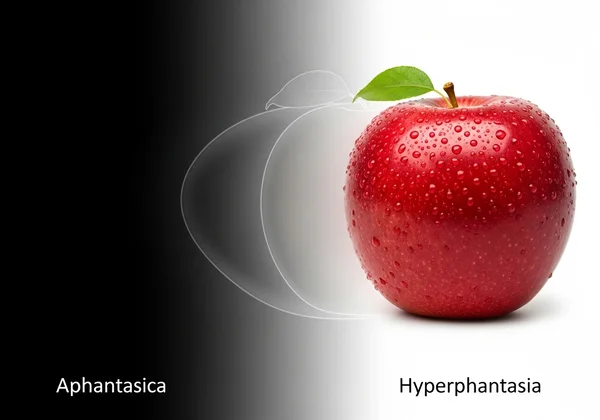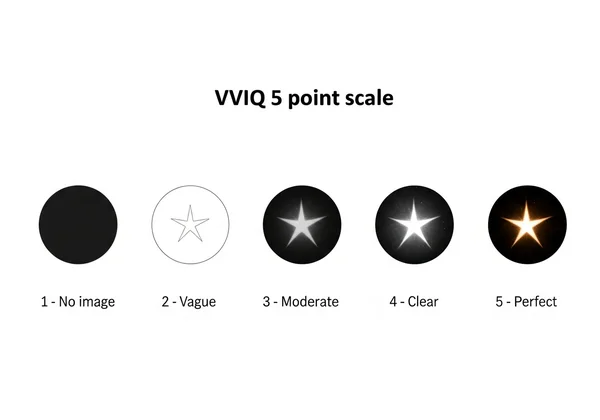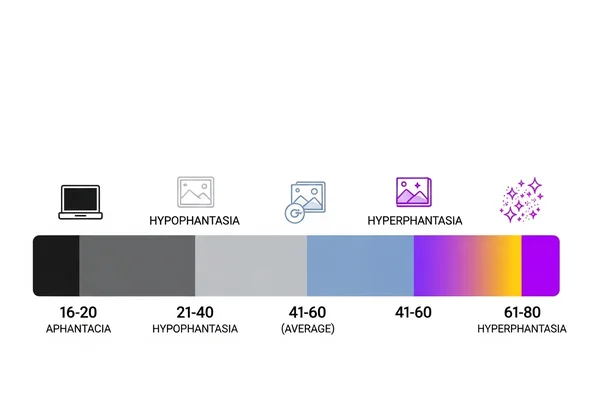Aphantasia Test: The VVIQ Science Behind Your Mind's Eye
Have you ever wondered how vividly you can "see" in your mind? When someone says "picture an apple," some people see a photorealistic red fruit, complete with a dewy shine. Others see a vague, ghostly outline. And for a portion of the population, their inner world is a blank screen—a conceptual space without images, a phenomenon known as aphantasia. This raises a crucial question for many: How to tell if you have aphantasia? The answer lies not in a simple yes-or-no question but in understanding the spectrum of our cognitive landscape.
On our aphantasia test platform, we are passionate about helping you explore this fascinating aspect of your consciousness. Our approach is inspired by decades of scientific research into mental imagery. This article will delve into the cornerstone of that research: the Visual Imagery Vividness Questionnaire (VVIQ). By understanding the science behind the VVIQ, you can appreciate the foundation of a reliable aphantasia test and feel confident as you start your self-assessment to discover where you fall on the spectrum of the mind's eye.

What is the Visual Imagery Vividness Questionnaire (VVIQ)?
The Visual Imagery Vividness Questionnaire (VVIQ) is a widely respected psychological tool designed to measure the clarity and liveliness of your mental imagery. Think of it as a standardized way to translate the highly personal and subjective experience of "seeing in your mind" into a quantifiable score. It doesn't judge your imagination; it simply provides a framework to help you evaluate its vividness.
For decades, the VVIQ has been a foundational instrument in cognitive science, allowing researchers and individuals alike to explore the vast differences in how we internally represent the world. It moves beyond a simple "I can see it" or "I can't" and asks, "How well can you see it?" This subtle but powerful distinction is key to understanding conditions like aphantasia and its opposite, hyperphantasia (exceptionally vivid imagery).
Tracing the Roots: How the VVIQ Was Developed
To truly trust a tool, it helps to know its origins. The VVIQ was developed by British psychologist David Marks and published in 1973. At the time, the study of mental imagery was challenging because it relied entirely on personal description, which can be vague and inconsistent. Marks sought to create a reliable, standardized method for cognitive science research.
He designed a series of prompts that ask participants to visualize specific scenarios—like a rising sun or a familiar shop—and then rate the vividness of the image on a simple scale. This innovation provided a common language and metric, paving the way for decades of groundbreaking aphantasia VVIQ research that has helped us understand the incredible diversity of the human mind. The test's longevity and widespread use in academic studies are a testament to its value and reliability.
How Does the VVIQ Scale Measure Your Mind's Eye?
The genius of the VVIQ lies in its simplicity and structure. The questionnaire presents you with several scenarios and asks you to visualize them with your eyes closed. For each scenario, you are prompted to consider the picture that comes to your mind and rate its vividness on a 5-point scale.
The VVIQ scale typically looks like this:
- 5: Perfectly clear and as vivid as normal vision.
- 4: Clear and reasonably vivid.
- 3: Moderately clear and vivid.
- 2: Vague and dim.
- 1: No image at all, you only "know" that you are thinking of the object.
By asking you to rate multiple scenarios, from simple objects to complex scenes, the test gathers data points to create an overall score. This score represents an average of your mental imagery vividness, providing a snapshot of your inner world. This is the trusted methodology that inspires our online aphantasia test.

The VVIQ Test Explained: Scoring and Interpretation
Once you've completed a VVIQ-based assessment, you're left with a score. But what does that number actually mean? Interpreting your score is the first step toward understanding your unique cognitive style. It's less about a diagnosis and more about an empowering insight into how your brain works.
This process of scoring and interpretation helps place you on the spectrum of visual imagination, providing a reference point for your personal experience. Whether you discover you have aphantasia, hyperphantasia, or fall somewhere in the middle, this knowledge can be profoundly validating.
Understanding Your VVIQ Score: What the Numbers Mean
The VVIQ consists of 16 questions, each rated from 1 to 5. The total score can range from 16 (indicating no visual imagery, or aphantasia) to 80 (indicating extremely vivid visual imagery, or hyperphantasia).
Here's a general guide to interpreting the scores:
- 16-20: This range is strongly indicative of aphantasia. Individuals in this bracket typically report a complete absence of voluntary visual imagery.
- 21-40: This suggests very low to low vividness of imagery (sometimes called hypophantasia). You may have fleeting, dim, or vague images.
- 41-60: This is considered the "average" range. Most people fall here, experiencing moderately clear and vivid mental pictures.
- 61-80: This range indicates highly vivid to exceptionally vivid imagery. A score toward the higher end suggests you may have hyperphantasia.
Remember, these numbers aren't labels. They are tools to help you articulate your subjective experience and understand that you're part of a wide spectrum of cognitive diversity.

Beyond the Score: Nuances and Limitations of the VVIQ
For a comprehensive understanding, it's crucial to approach any self-assessment tool with a balanced perspective. The VVIQ is an incredibly useful instrument, but it's important to recognize its limitations. Because it is a self-report questionnaire, its results depend on your introspection and honesty. It measures your perception of your own imagery, which is inherently personal.
Furthermore, the VVIQ is not a clinical diagnostic tool. It cannot "diagnose" you with aphantasia in a medical sense. Instead, it provides strong evidence and a scientifically-grounded starting point for your journey of self-discovery. It gives you the language and framework to understand your mind. If you're curious, you can discover your cognitive style with our free, user-friendly assessment.
VVIQ's Role in Aphantasia Research & Self-Assessment
The VVIQ has been instrumental in transforming aphantasia from a little-known curiosity into a recognized area of scientific inquiry. Before its widespread use, it was difficult for researchers to systematically study people who claimed they couldn't visualize. The VVIQ provided the necessary tool to identify and group individuals based on their imagery vividness.
This has allowed for targeted studies exploring everything from how people with aphantasia dream to how they approach memory tasks. For anyone questioning their own experience, a scientifically-inspired aphantasia self-assessment offers a private, accessible first step.
Why VVIQ is a Key Tool for Aphantasia Understanding
The VVIQ is a cornerstone for aphantasia understanding because it validates personal experience with objective-as-possible data. When someone scores consistently low, it provides external confirmation that their experience is real and shared by others. It helps distinguish the specific trait of imageless thought from other cognitive functions.
Researchers use the VVIQ to correlate low scores with other aphantasia traits, such as differences in autobiographical memory or the ability to recognize faces (prosopagnosia). This body of research, built upon the VVIQ, is what gives tools like ours their credibility and power to provide meaningful insight.
VVIQ and Your Journey to Explore Your Mind's Eye
Your mind is unique, and understanding its intricacies is an empowering journey. The principles of the VVIQ are more than just an academic exercise; they are a bridge to self-knowledge. When you take a test based on this framework, you are participating in a process of guided introspection that has been refined over half a century.
This isn't about finding out if you are "normal." It's about discovering your personal cognitive profile and learning to leverage its strengths. We invite you to explore your mind's eye and see where this fascinating journey of self-discovery takes you.

Unlocking Your Unique Cognitive Landscape
The Visual Imagery Vividness Questionnaire is more than just a test; it's a key that unlocks a deeper understanding of the mind's inner workings. It provides the scientific backbone for exploring the entire spectrum of visual imagination, from the complete darkness of aphantasia to the dazzling cinema of hyperphantasia. It confirms that whatever your experience is, it is valid and part of the rich tapestry of human consciousness.
Understanding the VVIQ builds trust and demystifies the process of self-assessment. It shows that behind the simple questions is a robust methodology designed to honor your unique experience.
Ready to see where you land on the spectrum? Begin your journey of self-discovery today. Take the free aphantasia test on our homepage and unlock a new perspective on your own mind. We'd love to hear about your experience in the comments below!
Frequently Asked Questions About Aphantasia & the VVIQ Test
Is the VVIQ test scientifically validated?
Yes, absolutely. The Visual Imagery Vividness Questionnaire (VVIQ) has been used and validated in hundreds of peer-reviewed scientific studies since its creation in 1973. It is considered a gold standard for self-reporting the vividness of mental imagery in cognitive science research.
Can the VVIQ diagnose aphantasia?
The VVIQ is a self-assessment tool, not a clinical diagnostic instrument. It can provide a very strong indication of where you fall on the visual imagery spectrum. A consistently low score is a primary indicator used to identify individuals with aphantasia for research and self-understanding, but it is not a formal medical diagnosis.
How to tell if you have aphantasia?
The most direct way to explore this is by trying to visualize things and honestly assessing what you experience. If you consistently find that you cannot form a mental picture and instead "think" in concepts, words, or feelings, you may have aphantasia. Taking a structured mind blindness test like ours, which is based on VVIQ principles, can provide a clearer answer. Try our free tool today.
Is aphantasia neurodivergent?
The term neurodivergent refers to brains that function differently from what is considered "typical." While not a formal medical condition, aphantasia is increasingly seen as a form of neurodivergence. It represents a natural variation in human cognition, just like dyslexia or synesthesia.
What do people with aphantasia dream?
This varies greatly! Some people with aphantasia report dreaming without any visual component—they just "know" what is happening, who is there, and what emotions are involved. Others report dreaming with visuals, suggesting that the mechanisms for voluntary visualization (while awake) and involuntary visualization (while dreaming) can be different.
Disclaimer: This article is for informational purposes only and does not constitute medical advice. The test on this website is a self-assessment tool and is not intended for clinical diagnosis. If you have concerns about your cognitive health, please consult a qualified healthcare professional.